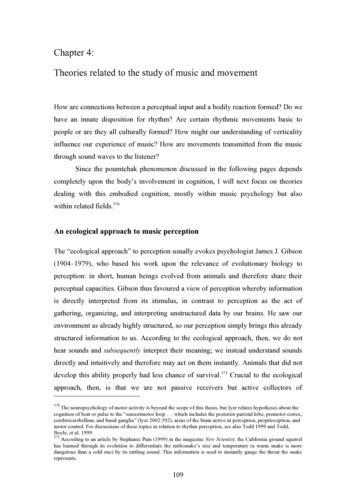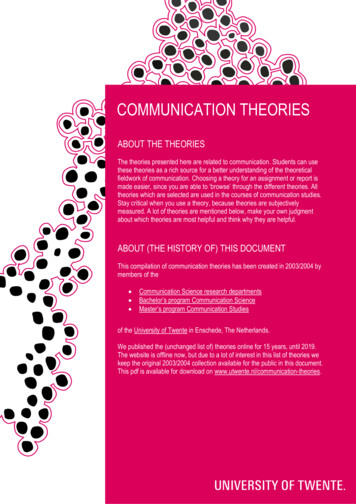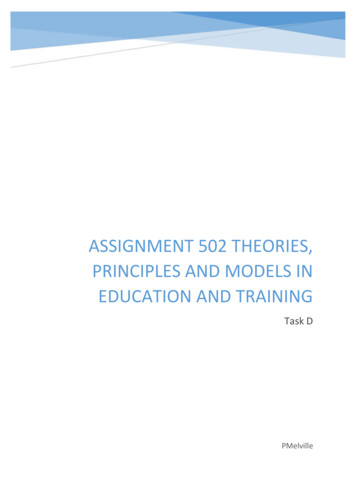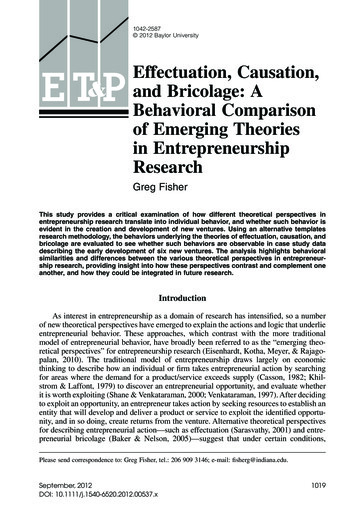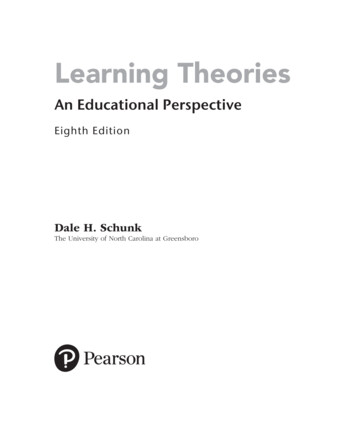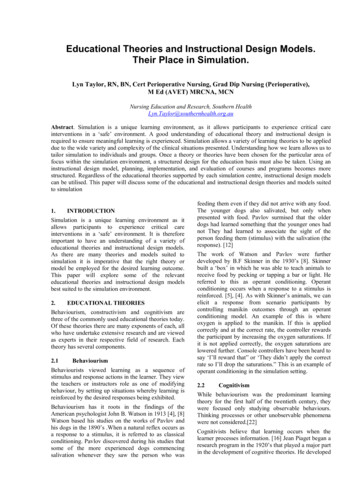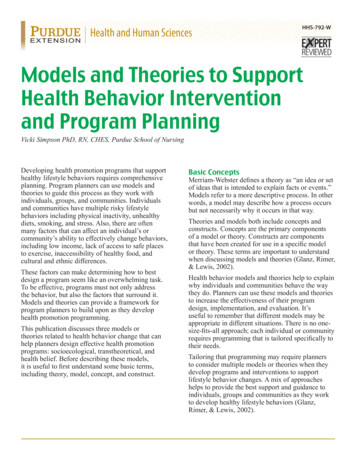
Transcription
05-Malloch-Chap056/3/085:52 PMPage 61Chapter 5The evolution of music:Theories, definitions and thenature of the evidenceIan Cross and Iain Morley5.1 IntroductionIt is nowadays uncontroversial among scientists that there is biological continuity betweenhumans and other species. However, much of what humans do is not shared with other animals.Human behaviour seems to be as much motivated by inherited biology as by acquired culture,yet most musical scholarship and research has treated music solely from a cultural perspective.Over the past 50 years, cognitive research has approached the perception of music as a capacity ofthe individual mind, and perhaps as a fundamentally biological phenomenon. This psychology ofmusic has either ignored, or set aside as too tough to handle, the question of how music becomesthe cultural phenomenon it undoubtedly is. Indeed, only over the past 10 years or so has thequestion of the ‘nature’ of culture received serious consideration, or have the operations of mindnecessary for cultural learning explicitly engaged the attention of many cultural researchers(D’Andrade 1995; Shore 1996). The problem of reconciling ‘cultural’ and ‘biological’ approachesto music, and indeed to the nature of mind itself, remains.One way of tackling this problem is to view music from an evolutionary perspective. The ideathat music could have evolutionary origins and selective benefits was widely speculated on in theearly part of the twentieth century, in the light of increasing bodies of ethnographic research andDarwinian theory (e.g., Wallaschek 1893). This approach fell rapidly out of favour in the yearsbefore the Second World War, for political as much as for scientific reasons, with the repudiationof biological and universalist ideas in anthropological and musicological fields (Plotkin 1997).However, evolutionary thinking has again become central in a range of sciences and in recentphilosophical approaches, and music’s relationship to evolutionary processes has been increasingly explored over the past two decades (see also Dissanayake, Chapters 2 and 24; Brandt,Chapter 3; Merker, Chapter 4, this volume).5.2 Music in evolutionary thinkingPrevious writings on the evolution of capacities for music have made one of two assumptions:either music is a by-product of other cognitive and physiological adaptations, or there are benefits associated with musical behaviour in its own right. Views advocating non-adaptive rootsfor music have been prominent over the past 20 years. A widely publicized view (Pinker 1997)proposes that the complex sound patterns of music make stimulating use of adaptations forlanguage, emotion and fine motor control, which evolved independently through selectivepressures not associated with any functions peculiar to music.
05-Malloch-Chap05626/3/085:52 PMPage 62IAN CROSS AND IAIN MORLEYMusic may not be essential for survival, as eating or breathing are, but, like talking, may confera selective benefit and express a motivating principle that has great adaptive power. Music mayhave developed from functions evolved for particular life-supporting purposes as a specializationthat elaborates and strengthens those same purposes. As Huron (2001, p. 44) puts it, ‘If musicis an evolutionary adaptation, then it is likely to have a complex genesis. Any musical adaptationis likely to be built on several other adaptations that might be described as pre-musical orproto-musical.’Let us consider the theories that have been proposed to explain how our capacity for musicmay have evolved.5.2.1Music promotes group cohesionRoederer (1984), like H. Papousek (1996) and Dissanayake (2000; and Chapters 2 and 24, thisvolume), proposes that music developed from mother–infant communication. The musicalmanner of their interaction, he suggests, strengthens emotional bonds between mother andinfant, and practices the extraction of speech information from the musical components of talk,such as vowels, inflections and the pitch cues cultivated in some oriental languages. Roederernotes that music can transmit emotional information to many people at once, equalizing theemotional state of the group, which results in a bonding effect between the group members. Thisis an effect clearly identified earlier in Blacking (1969).Sloboda (1985) observes that all cultures require the cognitive and social organization ofpractices and mental techniques for survival, and that while modern cultures have ‘manycomplex artefacts that help us to externalize and objectify the organizations we need and value’(Sloboda 1985, p. 267), in non-literate societies the ‘organizational structures’ must be evidencedand expressed primarily in terms of the expressive ways that people interact with one another.For example, music can provide a mnemonic framework for the knowledge of a community, aswell as a way of expressing the structure of social relations (Dissanayake, Chapters 2 and 24;Merker, Chapter 4, this volume).5.2.2Music is a product of group selectionThe potential function of music in selection at the level of the group needs to be assessed in thelight of the extensive debate within recent evolutionary thinking on the nature and existence ofmechanisms of selection at the group level. Shennan (2002), in a comprehensive evaluationof models of evolutionary selection applicable to theories of human prehistory, observes thatselection can occur at numerous levels, including that of the group. Group behaviours affect thesocial environment in which individuals live, feed and breed. As Shennan puts it,All theoretical schools, including those that are sceptical about other levels of evolutionary processthan that of individual inclusive fitness, recognize that such [individual] interests may often be servedby co-operating rather than competing with other individuals of the same species.(2002, p. 213)In consequence of frequent interaction with the same people, an individual’s behaviours arelikely to acquire the form of approved prosocial norms that emerge within a population.Adherence to these norms can benefit the members of the group by giving additional rewardsfor behaviours that they choose to undertake as individuals (Bowles and Gintis 1998). Inother words, optimal behaviours for the well-being of an individual can be determinedthrough engagement with conspecifics, as well as between each individual and their non-humanenvironment. In a social species, the likelihood that individuals will survive to procreate or have a
05-Malloch-Chap056/3/085:52 PMPage 63THE EVOLUTION OF MUSIC: THEORIES, DEFINITIONS AND THE NATURE OF THE EVIDENCEhigh rate of procreation depends on their ‘cultural fitness’—how they behave in relation to othersin their social group, not just their physical fitness.Behaviours that contribute to ‘group cohesiveness’ may make other cooperative behavioursmore likely. Bowles and Gintis (1998) have demonstrated through their game theory model that‘populations [without a centralizing control] whose interactions are structured in such a way thatcoordination problems are successfully overcome will tend to grow, to absorb other populations,and to be copied by others’ (Shennan 2002, p. 216).It can be seen that the emergence of musical behaviours as a prosocial norm assistingcoordination within a group could lead to the growth of such groups and the spread of thosebehaviours. Not only could musical behaviours become a behavioural norm in their own right,but, because of their foundations in powerful motives for social awareness and expressivebehaviours, those individuals with well-developed capacities for musical action and perceptionshould also be best at identifying and engaging with other norms of social interactive behaviour.Therefore, in theory, musical behaviours fit well with the models of selection, at both individualand group levels, that demonstrate how the development and spread of musical behavioursis possible.5.2.3Socio-emotional bonding is favoured by evolutionof musical signallingBrown (2000a) proposes that music and language have common origins in a single communicative system (see also Scherer 1991). According to Brown, both music and language can beconceived of as functioning at ‘phonological’ and ‘meaning’ levels. The stream of sonic eventsthat constitutes spoken language is interpreted as lexical items by means of a ‘phonologicalsystem’, the output of which feeds into a ‘propositional system’ for the production of speech,within which units have both relational (syntactical) and referential (semantic) value.Analogously, a phonological system can be conceived of as transforming a stream of musicalsounds into discrete entities (e.g., motifs, harmonic configurations), that is, ‘fed into a systemof pitch-blending syntax that specifies a set of relationships between sound patterns andemotions [which] deals with the issues of sound emotion, tension and relaxation, rhythmicpulse and the like’ (p. 274). In this model, systems for dealing with sound information in bothmusic and speech are identified as dissociated but employing comparable tiers of ‘processing’,each derived from a common set of hypothetical principles for interpreting and generatingphrasing in action and experience (see also Brandt, Chapter 3, this volume).Brown proposes that this common set of principles arose first as a unitary vocal communicative medium, ‘musilanguage’, and that language and music then became separate capacitiesthough a process of divergence and functional specialization. Language came to fulfil propositional functions such as the expression of ‘truth values’, whereas music came to constitute apre-eminently social or interpersonal phenomenon. He suggests that, ‘the principal function ofmusic making is to promote group cooperation, coordination and cohesion’ (p. 296).Brown subsequently (2000b) adds the notion of music as reinforcing ‘groupishness’, which hedefines as a ‘suite of traits that favour the formation of coalitions, promote cooperative behaviourtowards group members and create the potential for hostility towards those outside the group’(p252). Music supports these traits through the opportunities that it offers for the formation andmanifestation of group identity, for the conduct of collective thinking (as in the transmission ofgroup history and planning for action), for group coordination through synchronization (thesharing of time between members of a group), and for group catharsis (the collective expressionand experience of emotion). Ultimately, Brown sees music as having become established63
05-Malloch-Chap05646/3/085:52 PMPage 64IAN CROSS AND IAIN MORLEYin human cultures through its role as ‘ritual’s reward system’; music, for him, is a type of‘modulatory system acting at the group level to convey the reinforcement value of theseactivities for survival’ (p. 257). For Brown, music’s survival value is thus not immediate andindividual, but lies in its ability to promote group cohesion.A different position is adopted by Hagen and Bryant (2003), who suggest that rather thancausing social cohesion, music and dance signal social cohesion achieved by other means. Hagenand Bryant’s overall thesis is thatFor humans and human ancestors, musical displays may have functioned, in part, to defend territory(and perhaps also to signal group identity), and that these displays may have formed the evolutionarybasis for the musical behaviours of modern humans.(2003, p. 25)They propose that music and dance act as indicators of group stability and the ability to carry outcomplex coordinated actions (as exemplified, perhaps, in the New Zealand All Blacks’ footballcry, haka). They propose that the time needed to create and practice music and dance corresponds to the quality of the coalition performing them, indicating how much time they havedevoted to preparing their skill.Hagen and Bryant justify their position, and reject other explanations, on the grounds thatmusical behaviours cannot contribute directly to the cohesion of a group, because they are not agood indicator of an individual’s ability to contribute to the group’s survival. However, this viewof group cohesion purely in terms of immediately perceived costs and benefits of group membership ignores emotional bonding and the loyalty engendered by a mutual emotional experience.Individuals may already have established their credibility within a group, in terms of their abilityto contribute to its survival, but this provides no indication of their likelihood of doing so, or towhom they will direct their assistance. The ability of music to act as a forum for the practice ofintegrated, complex, coordinated group activities resulting in a powerful sense of membershipand trust provides a coherent explanation as to why these behaviours persisted at a group level.One of the manifestations of this role may have been ‘coalition signalling’, and this may even haveled to its perpetuation; however, this is unlikely to have been the primary selective force formusic’s development.At a psychobiological and individual level, rather than a behavioural and social level, musicalexperience has been linked with the release and action of life-sustaining regulatory hormones.Freeman (1995) reports that the neuropeptide transmitter oxytocin aids in the formation ofstrong positive emotional memories and in the supplanting of negative emotional memories,having its strongest effects during trauma or ecstasy. Oxytocin is released into the brain infemales during lactation, and is produced by males and females following sexual orgasm. It mediates in interpersonal bonding, both pair-bonding and mother–infant bonding. Critically,Freeman suggests that oxytocin is likely to be released while a person is merely listening to music.This would provide a strong neurological rationale for the role of music in the formationof social bonds, both in intimate interactions between people and in group musical activitiessuch as crowd chants (Huron 2001; see Pan
The evolution of music: Theories, definitions and the nature of the evidence Ian Cross and Iain Morley 5.1 Introduction It is nowadays uncontroversial among scientists that there is biological continuity between humans and other species. However, much of what humans do is not shared with other animals. Human behaviour seems to be as much motivated by inherited biology as by acquired culture .

